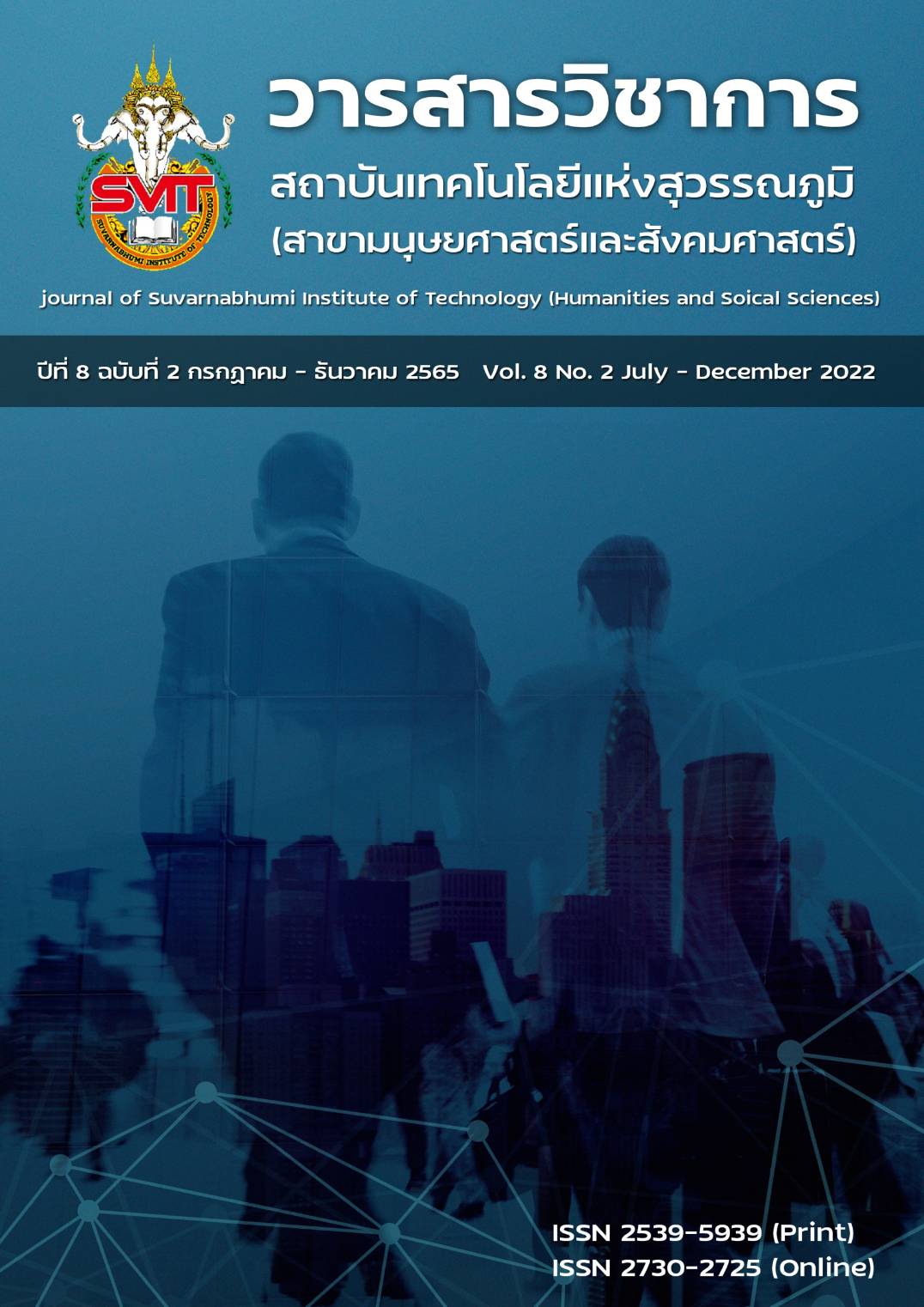THE ACHIEVEMENTS DEVELOPMENT FOR CURRICULUM AND LEARNING MANAGEMENT SCIENCE BY USING INTEGRATED WITH COACHING AND ACTIVE LEARNING METHODS FOR UNDERGRADUATES OF SUVARNABHUMI INSTITUTE OF TECHNOLOGY
Keywords:
The achievements development, Active Learning Methods.Abstract
The objectives of this research were to 1) The achievements development for curriculum and learning management science by using integrated with coaching and active learning methods for undergraduate students. 2) Compare academic achievement before and after classes by using integrated with coaching and active learning methods for undergraduate students. 3) Study students' satisfaction with curriculum and learning management science by using integrated with coaching and active learning methods for undergraduate students. The samples used in this research included 30 undergraduate students which was obtained through purposive sampling. Guidance learning management is combined with proactive learning management. Mean ( ) Standard Deviation (S.D.) and T-test 1) A learning management plan of curriculum and learning management science by using integrated with coaching and active learning methods for undergraduate students. 2) Pre- and post-study achievement tests are 30 selective responses with a confidence value of 0.85. 3). Statistics used to analyze data include percentages, averages, standard deviations. S.D. and t-test statistics, findings showed that 1) Quality of learning management for Curriculum and learning management science by using integrated with coaching and active learning methods are of the highest quality (x = 4.66. S.D. = 0.46). 2) The results of comparing student achievement showed that pre-school achievement averaged 13.80 points, representing 69 percent, and after school averaged 18.60 points, representing 93 percent, which was statistically significantly higher than pre-school at .05.and 3) The results of the study of satisfaction with curriculum and learning management science by using integrated with coaching and active learning methods were at the highest level (x = 4.81, S.D.= 0.37).
References
กิดานันท์ มลิทอง.(2556). สื่อการสอนและฝึกอบรมจากสื่อพื้นฐานถึงสื่อดิจิทัล.กรุงเทพฯ:จุฬาลงกรณ์มหาวิทยาลัย.
เดชดนัย จุ้ยชุม, เกษรา บ่าวแช่มช้อย และศิริกัญญา แก่นทอง. (2559). การพัฒนาผลสัมฤทธิ์ทางการเรียน เรื่อง ทักษะการคิดของนักศึกษาในรายวิชาทักษะการคิด (Thinking Skills) รหัส วิชา 11-024-112 ภาคเรียนที่ 1 ปีการศึกษา 2558 ด้วยการเรียนรู้แบบมีส่วนร่วม (Active Learning). นราธิวาส:คณะศิลปะศาสตร์ มหาวิทยาลัยนราธิวาสราชนครินทร์.
รสิตา รักสกุล, สุวรรณา สมบุญสุโข, และก้องกาญจน์ วชิรพนัง. (2558). สัมฤทธิ์ผลของการจัดการเรียนการสอนแบบบูรณาการ โดยใช้ Active Learning ของ นักศึกษาในรายวิชาการบริหารจัดการยุคใหม่และภาวะผู้นำมหาวิทยาลัย เทคโนโลยีพระจอมเกล้าธนบุรี. การประชุมวิชาการระดับชาติ มหาวิทยาลัยรังสิต ประจำปี 2559 (RSU National Research Conference 2015) วันศุกร์ที่ 24 เมษายน 2558 ณ ห้อง Auditorium ชั้น 2 อาคาร Digital Multimedia Complex (ตึก 15) มหาวิทยาลัยรังสิต.
วิจารณ์ พานิช.(2555).วิถีสร้างการเรียนรู้เพื่อศิษย์ในศตวรรษที่ 21.กรุงเทพฯ : มูลนิธิสดศรี-สฤษดิ์วงศ์.
สถาพร พฤฑฒิกุล.(2558). คุณภาพผู้เรียน เกิดจากกระบวนการเรียนรู้. สระแก้ว: คณะเทคโนโลยี การเกษตรมหาวิทยาลัยบูรพา วิทยาเขตสระแก้ว.
อุเทน ทักคุ้ม. (2555). การเปรียบเทียบผลสัมฤทธิ์ ทางการเรียนและกระบวนการคิดวิเคราะห์ ระหว่างการสอนโดยใช้กิจกรรมการเรียนรู้แบบกระตือรือร้นกับการสอนโดยใช้กิจกรรมการเรียนรู้แบบปกติ หน่วยการเรียนรู้ ย่อย เรื่อง ระบบขับถ่ายกับการรักษาดุลยภาพของร่างกายวิชาชีววิทยาของนักเรียนชั้นมัธยมศึกษาปีที่ 4 (ออนไลน์). สืบค้นจาก: https://www.tci-thaijo.org (7 พฤศจิกายน 2557)
Bonwell and Eison. (1991). Active Learning: Creating Excitement in the Classroom. ERIC Digest. Washington D.C.: ERIC Clearinghouse on Higher Education.
Whitmore, J. (2009). Coaching for Performance: Growing People, Performance, and Purpose.from www.performanceconsultants.com./Grow-model
Downloads
Published
Issue
Section
License
Copyright (c) 2022 Suvarnabhumi Institute of Technology

This work is licensed under a Creative Commons Attribution-NonCommercial-NoDerivatives 4.0 International License.
บทความที่ได้รับการตีพิมพ์เป็นลิขสิทธิ์ของวารสารวิชาการ สถาบันเทคโนโลยีแห่งสุวรรณภูมิ
ข้อความที่ปรากฏในบทความแต่ละเรื่องในวารสารวิชาการเล่มนี้เป็นความคิดเห็นส่วนตัวของผู้เขียนแต่ละท่านไม่เกี่ยวข้องกับสถาบันเทคโนโลยีแห่งสุวรรณภูมิ และคณาจารย์ท่านอื่นๆในสถาบันฯ แต่อย่างใด ความรับผิดชอบองค์ประกอบทั้งหมดของบทความแต่ละเรื่องเป็นของผู้เขียนแต่ละท่าน หากมีความผิดพลาดใดๆ ผู้เขียนแต่ละท่านจะรับผิดชอบบทความของตนเองแต่ผู้เดียว





